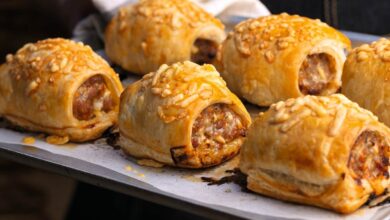Does pairing wine with food actually work or is it all poncy nonsense?

Pairing food and wine is one of the great culinary pleasures, whether you are opening a bottle for a romantic dinner by candlelight or having a glass with a bag of potato chips. But it can also be one of the most mystifying and intimidating elements of planning a meal.
What ought to be a joy often produces a feeling of dread and the fear of making mistakes. That anxiety can set in for both occasional wine drinkers and regular consumers.
To allay the fears of an embarrassing failure, many people will look for recommendations or turn to books about the art of pairing food and wine.
It makes sense to seek advice from more experienced people, except that advice is often uncomfortably specific, implying that only one bottle can do the trick, or mind-bogglingly complicated. It can be wrapped in a formulaic approach directed at food-and-wine professionals that promises success but requires more knowledge about the chemistry of food and wine than most people possess.
Over many years of recommending wines with recipes and opening bottles with meals, my primary mode of consuming wine, I have come to believe several essential truths about pairing wine and food. These truths may not promise success, but I hope they help to ease the fears of selecting wines.
The first step, especially if you are relatively new to wine, is to get some welcome help. How? Buy your wine at a good wine shop rather than a supermarket or big box store. Not only will this step improve the general quality of the wine you drink, it will make available to you some good sources of advice.
Dedicated merchants know a lot about wine and are almost always eager to help. Tell them what you are planning to eat and ask for recommendations within your budget.
That’s an easy way to begin, and will lead to some good pairings. It’s an insurance policy when you really need help, and it will give you a set of ideas to work with in the future. But to develop your own instincts, you’ll need to start making decisions yourself, owning the triumphs, risking setbacks and building a well of experience.
Wine and food go together like two beautiful harmonising voices, creating a blend that outshines either of the individual deliveries. This is the ideal, at least. It rarely works out that way.
Most food and wine pairings are not perfect. But even if a bottle and a dish do not meld synergistically, they can still enhance one another.
The simpler the recipe – that is, the fewer the ingredients – the easier it is to find that beautiful harmony. Even so, pairings are subjective and often depend on individual psychology rather than chemistry between a food and beverage.
For example, I do not like to drink Champagne with oysters. I find the combination creates a metallic taste and prefer Chablis or Muscadet. But try telling that to the many people who love the two together, or to the scientists who say they have demonstrated why the pairing works so well.
Many people assume every dish has its perfect match, the one wine that, with a particular recipe, will make magic. The simpler the dish, the greater the range of possibilities. Sure, you can enjoy a Napa Valley cabernet sauvignon with a steak. You could also enjoy a Bordeaux, a Burgundy, a Chianti Classico, a zinfandel or a Rioja Reserva, just to name a few options.
Professionals might argue that certain wines go better with certain cuts of steak, or with different methods of cooking. But that would be nitpicking – I mean, that’s what sommeliers do, and that’s fine for them.
It’s their job to intimately acquaint themselves with a chef’s menu in all its complexity and to envision the best match on their wine list, which they should also know inside and out, in pursuit of pairing nirvana. Most ordinary consumers don’t have that level of commitment or the time, desire and resources to achieve it. But they can still select wines that will enhance most meals.
There’s no reason to think that white and sparkling wines would be disastrous with red sauce
The basic premise is that the more bottles you try of more different sorts of wine, the better you will understand your own taste. And the better you know your preferences, the easier it becomes to make your own choices rather than rely on help from experts.
This is doubly true of pairing wine and food. Those sommeliers recommending the best bottle with the chef’s rendition of halibut with ginger and caramelised fennel? They weren’t born with that knowledge. It came through years of trial and error.
For example, a colleague asked me what white wines I would choose with dishes that we ordinarily serve with red wines, like pizza, pasta with cooked tomato sauce or steak. My answer: I’m not sure. Try a white wine you like and see what you think.
That perhaps sounds flippant, but I’m serious. Years ago in Germany, a winemaker demonstrated what he considered a wonderful pairing: a 20-year-old riesling auslese with a steak. It was a delicious combination. The richness of the wine’s texture was intact after 20 years, though most of the sweetness had faded into an umami quality that went unexpectedly well with the beef.
Almost never is one wine the correct and only choice. You do not have to worry about choosing the perfect bottle because many bottles are the right choice and very few are wrong





